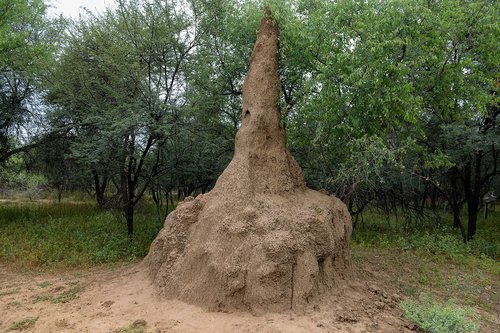创新背景
白蚁只有几毫米长,但它们的巢可以高达4米——相当于人类建造了一座加州惠特尼山高度的房子。观察白蚁巢穴,会看到一个由不对称、相互连接的结构组成的网络,比如面包或海绵的内部。由沙粒,灰尘,污垢,唾液和粪便制成,这种无序的,不规则的结构看起来很随意,但白蚁巢专门针对稳定性和通风进行了优化。
创新过程
通过了解白蚁如何促进巢穴的制造,研究人员可以定义设计具有独特机械性能的建筑材料的简单规则。建筑材料是泡沫状或复合固体,包括构建块,然后将其组织成从纳米级到微米级的3D结构。到目前为止,架构材料领域主要集中在周期性结构上——这种架构包含一个均匀的几何单元,如八面体或立方体,然后重复这些单元以形成晶格结构。然而,专注于有序结构限制了建筑材料的功能和使用。

周期性架构对工程师来说很方便,因为他们可以在分析其属性时做出假设。但是如果考虑应用,它们不一定是最佳设计选择。无序结构,如白蚁巢的结构,在自然界中比周期性结构更普遍,并且通常显示出优越的功能。但是直到现在,工程师还没有找到一种可靠的方法来设计它们。
工程师们最初解决这个问题的方式是考虑白蚁有限的资源。当它筑巢时,白蚁没有整体巢穴设计的蓝图;它只能根据当地规则做出决定。例如,白蚁可能会使用在巢穴附近发现的沙粒,并按照从其他白蚁那里学到的程序将颗粒组合在一起。圆形沙粒可以放在半月形旁边,以提高稳定性。这种基本的邻接规则可以用来确定如何建造白蚁巢。工程师们为材料设计创建了一个数值程序,具有类似的规则,定义了两个不同的材料块如何相互粘附。
Daraio及其团队称之为“虚拟生长计划”的算法模拟了生物结构的自然生长,或白蚁巢的制造。虚拟生长计划使用独特的材料几何形状或构建块,以及这些构建块如何相互附着的邻接指南,而不是一粒沙子或灰尘斑点。此初始工作中使用的虚拟块包括 L 形、I 形、T 形和 + 形。此外,每个构建块的可用性都有一个定义的限制,与白蚁在自然界中可能遇到的有限资源并行。利用这些约束,程序在网格上构建架构,然后将这些架构转换为2-D或3-D物理模型。

研究人员的目标是生成无序几何结构,其属性由一些基本形状的组合空间定义,例如直线,十字或”L”形。然后,这些几何形状可以根据应用的要求,用各种不同的本构材料进行3D打印。
镜像白蚁巢的随机性,由虚拟生长程序创建的每个几何形状都是独一无二的。例如,改变L形构建块的可用性会导致一组新的结构。Daraio和团队尝试了虚拟输入,以生成超过54,000个模拟架构样本;样品可以聚类成具有不同机械特性的组,这些组可能决定材料的变形方式,刚度或密度。通过绘制构建块布局,资源可用性和由此产生的机械特征之间的关系,Daraio和团队可以分析无序结构的基本规则。这代表了材料分析和工程的全新框架。
创新关键点
虚拟生长计划使用独特的材料几何形状或构建块,以及这些构建块如何相互附着的邻接指南,而不是一粒沙子或灰尘斑点。此初始工作中使用的虚拟块包括 L 形、I 形、T 形和 + 形。此外,每个构建块的可用性都有一个定义的限制,与白蚁在自然界中可能遇到的有限资源并行。利用这些约束,程序在网格上构建架构,然后将这些架构转换为2-D或3-D物理模型。
创新价值
虚拟生长计划通过模拟白蚁建造巢穴的方式而不是复制巢穴本身的配置来探索无序材料的未知前沿。这项研究旨在控制材料中的无序,以使用以前未被利用的设计和分析工具改善机械和其他功能特性。这项研究有助于了解材料设计的基本规则,然后创造出比目前在工程中使用的材料具有优越性能的材料。
The disordered structure in the material can be controlled by the new frame
By understanding how termites facilitate nest manufacturing, researchers can define simple rules for designing building materials with unique mechanical properties. The building material is a foam-like or composite solid, consisting of building blocks, which are then organized into 3D structures ranging from nanoscale to micron scale. So far, the field of architectural materials has focused on periodic structure-architectures that contain a uniform geometric unit, such as an octahedron or cube, which is then repeated to form a lattice structure. However, the focus on ordered structure limits the functionality and use of building materials.
Periodic architectures are convenient for engineers because they can make assumptions when analyzing their properties. But if you think about applications, they're not necessarily the best design choice. Disordered structures, such as those of termite nests, are more prevalent in nature than periodic structures and generally show superior function. But until now, engineers have not found a reliable way to design them.
The way engineers initially tackled this problem was by considering termites' limited resources. When it builds a nest, the termite has no blueprint for the overall nest design; It can only make decisions based on local rules. For example, termites may use sand grains found near their nests and assemble the grains following a procedure learned from other termites. Round grains of sand can be placed next to the half-moon shape to improve stability. This basic adjacency rule can be used to determine how to build termite nests. The engineers created a numerical program for the material design, with similar rules that define how two different blocks of material adhere to each other.
The algorithm Daraio and his team call "virtual growth planning" mimics the natural growth of biological structures, or the creation of termite nests. Instead of a speck of sand or dust, virtual growth plans use unique material geometry or building blocks, and an adjacency guide to how those building blocks adhere to each other. The virtual blocks used in this initial effort include L-shapes, I-shapes, T-shapes, and + shapes. In addition, there is a defined limit to the availability of each building block, in parallel with the limited resources termites may encounter in nature. Using these constraints, the program builds architectures on a grid and then transforms these architectures into 2-D or 3-D physical models.
The goal of the researchers is to generate disordered geometries whose properties are defined by the combined space of some basic shapes, such as lines, crosses or "L" shapes. These geometry can then be 3D-printed with a variety of different constitutive materials, depending on the requirements of the application.
The randomness of the mirror termite nest, each geometry created by the virtual growth program is unique. For example, changing the availability of L-shaped building blocks results in a new set of structures. Daraio and his team experimented with virtual inputs to generate over 54,000 simulated architecture samples; Samples can be clustered into groups with different mechanical properties that may determine the deformation mode, stiffness or density of the material. By mapping the relationship between building block layouts, resource availability, and the resulting mechanical features, Daraio and his team can analyze the basic rules of disordered structure. This represents an entirely new framework for materials analysis and engineering.
智能推荐
智能制造 | 新型“材料显微外科”技术可提高废物回收效率
2022-09-27新南威尔士大学可持续材料研究与技术中心(SMaRT)的“微回收科学”先驱们开发出了一项有望提升先进制造业的新技术。
涉及学科涉及领域研究方向新材料 | 创新开发新系统“micro-CAL”可在玻璃结构中打印微尺度特征
2022-11-08加州大学伯克利分校的研究人员开发了一种3D打印玻璃微结构的新方法,该方法速度更快,可以生产出具有更高光学质量,设计灵活性和强度的物体。
涉及学科涉及领域研究方向新材料 | 创新制备氧化锆陶瓷可作为新型记忆材料
2022-10-10研究人员发现了一类由陶瓷而不是金属制成的新型形状记忆材料可能会开辟一系列新的应用,特别是对于高温设置,例如喷气发动机内部的致动器或深钻孔。
涉及学科涉及领域研究方向创新使用木质涂料降低医院器具表面的微生物
2022-08-02将树脂和树皮与医院使用的抗菌材料进行对比,考虑木质涂料的可用性。
涉及学科涉及领域研究方向